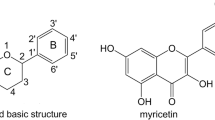Abstract
Flavonoids are among the most important bioactive compounds responsible for the medical properties of honey and propolis. Water is the solvent most commonly used to extract flavonoids from honey and propolis. Hydrogen-bonding interactions are of great importance in the extraction process. In this work, hydrogen-bonding interactions between a representative flavonoid, luteolin, and water were investigated by density functional theory (DFT) from a theoretical viewpoint. The following conclusions were drawn: first, the molecular structure of luteolin is non-planar. Second, nine optimized geometries for the luteolin–H2O complex were obtained. With the exception of the aromatic hydrogen atoms in the phenyl substituent, the other hydrogen and oxygen atoms formed hydrogen-bonds with H2O. Third, luteolin–H2O complexation is accompanied by charge rearrangement. The electron density and the second-order perturbation stabilization energy [E(2)] in the related anti-bonding orbital of the hydrogen-bond donors were increased, causing elongation and a red-shift of the X−H bond in X−H···Y. The stronger interaction makes the electron density and the E(2) increase more in the more stable geometries. The sum of the electron density is transferred from hydrogen-bond acceptors to donors. Fourth, the hydrogen-bonds in the luteolin−H2O complex are weak and basically electrostatic in nature. In addition, O−H···O hydrogen-bonds are stronger than C−H···O hydrogen-bonds in the luteolin–H2O complex.





Similar content being viewed by others
References
Ghisalberti EL (1979) Bee world 60:59
Irish J, Blair S, Carter DA (2011) PLoS One 6:e18229
Gheldof N, Wang XH, Engeseth NJ (2002) J Agric Food Chem 50:5870
Kumazawa S, Ueda R, Hamasaka T et al (2007) J Agric Food Chem 55:7722
Sroka Z, Żbikowska B, Hładyszowski J (2015) J Mol Model 21:307
Islam A, Khalil I, Islam N et al (2012) BMC complementary and alternative medicine 12: 177
Arunan E, Desiraju GR, Klein RA et al (2011) Pure Appl Chem 83:1637
Scheiner S (1997) Hydrogen bonding. Oxford University Press, New York
Lee SH, Doherty TV, Linhardt RJ et al (2009) Biotechnol Bioeng 102:1368
Oliveira BG, Araújo RCMU, Carvalho AB et al (2009) J Mol Model 15:123
Oliveira BG, Lima MCA, Pitta IR et al (2010) J Mol Model 16:119
Clark T, Hennemann M, Murray JS et al (2007) J Mol Model 13:291
Li QZ, An XL, Gong BA et al (2007) J Phys Chem A 111:10166
Li QZ, Lin QQ, Li WZ et al (2008) ChemPhysChem 9:2265
Li QZ, Wu GS, Yu ZW (2006) J Am Chem Soc 128:1438
Dega-Szafran Z, Katrusiak A, Szafran M (2006) J Mol Struct 785:160
Szafran M, Katrusiak A, Dega-Szafran Z (2007) J Mol Struct 839:99
Ireta J, Neugebauer J, Scheffler M (2004) J Phys Chem A 108:5692
Köddermann T, Wertz C, Heintz A et al (2006) ChemPhysChem 7:1944
Knorr A, Ludwig R (2015) Sci Rep 5:17505
Zheng YZ, Wang NN, Luo JJ et al (2013) Phys Chem Chem Phys 15:18055
Frisch MJ, Trucks GW, Schlegel HB, Scuseria GE, Robb MA, Cheeseman JR, Scalmani G, Barone V, Mennucci B, Petersson, GA, Nakatsuji H, Caricato M, Li X, Hratchian HP, Izmaylov AF, Bloino J, Zheng G, Sonnenberg JL, Hada M, Ehara M, Toyota K, Fukuda R, Hasegawa J, Ishida M, Nakajima T, Honda Y, Kitao O, Nakai H, Vreven T, Montgomery JA, Jr., Peralta JE, Ogliaro F, Bearpark M, Heyd JJ, Brothers E, Kudin KN, Staroverov VN, Kobayashi R, Normand J, Raghavachari K, Rendell A, Burant JC, Iyengar SS, Tomasi J, Cossi M, Rega N, Millam NJ, Klene M, Knox JE, Cross JB, Bakken V, Adamo C, Jaramillo J, Gomperts R, Stratmann RE, Yazyev O, Austin AJ, Cammi R, Pomelli C, Ochterski JW, Martin RL, Morokuma K, Zakrzewski VG, Voth GA, Salvador P, Dannenberg JJ, Dapprich S, Daniels AD, Farkas Ö, Foresman JB, Ortiz JV, Cioslowski J, Fox DJ (2009) Gaussian09. Revision B.01. Gaussian Inc, Wallingford CT
Zhao Y, Truhlar DG (2008) Theor Chem Account 120:215
Reed AE, Curtiss LA, Weinhold F (1988) Chem Rev 88:899
Bader RFW (1994) Atoms in molecules: a quantum theory. Clarendon, Oxford
Boys SF, Bernardi F (1970) Mol Phys 19:553
Lu T, Chen F (2012) J Comput Chem 33:580
Li LC, Hu F, Cai WF et al (2009) J Mol Struct THEOCHEM 911:98
Cox PJ, Kumarasamy Y, Nahar L, Sarker SD, Shoeb M (2003) Acta Cryst E59:0975
Pauling L (1960) The nature of the chemical bond. Cornell University Press, New York
Roohi H, Nowroozi AR, Anjomshoa E (2011) Comput Theor Chem 965:211
Rozas I, Alkorta I, Elguero J (2000) J Am Chem Soc 122:11154
Pacios LF (2004) J Phys Chem A 108:1177
Acknowledgments
We thank Dr. Hong-Yan He from Bei**g Key Laboratory of Ionic Liquids Clean Process, who gave important advice on data analysis. This work was supported by the earmarked fund for China Agriculture Research System (CARS-45-KXJ7).
Author information
Authors and Affiliations
Corresponding authors
Electronic supplementary material
Below is the link to the electronic supplementary material.
ESM 1
(DOCX 19 kb)
Rights and permissions
About this article
Cite this article
Zheng, YZ., Zhou, Y., Liang, Q. et al. Theoretical studies on the hydrogen-bonding interactions between luteolin and water: a DFT approach. J Mol Model 22, 257 (2016). https://doi.org/10.1007/s00894-016-3128-4
Received:
Accepted:
Published:
DOI: https://doi.org/10.1007/s00894-016-3128-4




